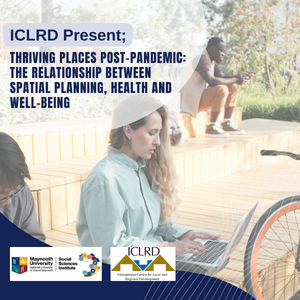This webinar seeks to explore some of the key movements we see emerging in a post-pandemic planning context. Where and how does health and well-being ‘fit’ into spatial planning policy and practice?

The focus of spatial planning has come full circle – from its origins rooted in growing concerns with public health and slum conditions across industrial cities in the 19th Century (Scott et al, 2018; Barton, 2009) to a renewed interest in the relationship between spatial planning and ‘health and wellbeing’ in the 21st Century (Scott et al, 2018; Kent and Thompson, 2014). This inter-relationship between planning and health was further concretised during COVID-19 when the international narrative positively turned to ‘building back better’ and creating resilient places and liveable communities that were grounded in sustainable development principles.
Martino et al (2021) define liveability as the ability of “spaces to fulfil the expectations of its inhabitants for wellbeing and quality of life”. This webinar seeks to explore some of the key movements emerging in a post-pandemic planning context. Where and how does health and well-being ‘fit’ into spatial planning policy and practice? What have the responses in 2020 and 2021 to the socio-economic and health threats of the COVID-19 pandemic taught us as designers, providers and users of space and place? Has the past two+ years shed any light on the type of places we want to live and work in?
Moderator
Ms. Caroline Creamer, Director, International Centre for Local and Regional Development (ICLRD)
Speakers
Transformative Health and Regeneration Initiatives for enhancing Liveability and Well-being: Reflections from Belfast THRI[VES]
Dr. Gavan Rafferty, Lecturer in Spatial Planning and Development, Ulster University
Who makes a healthy city? Working together for health in Derry and Strabane’
Ms. Erin Mc Feely, Chief Executive, Developing Healthy Communities NI
Negotiating the Complexity of Health in Cross-Border Territorial Cooperation
Ms. Caitriona Mullan, Independent Consultant and Senior Research Fellow, ICLRD
Respondent
Mr. Odran Reid, Lecturer, School of Environment and Planning, TU Dublin
Q&A
References:
Barton, H. (2009) Land use planning and health and well-being. Land Use Policy, 26, pp.115-123.
Kent, J. L., & Thompson, S. (2014). The three domains of urban planning for health and wellbeing. Journal of planning literature, 29(3), pp.239-256.
Martino, N., Girling, C., & Lu, Y. (2021). Urban form and livability: socioeconomic and built environment indicators. Buildings and Cities, 2(1), pp. 220–243. DOI: http://doi.org/10.5334/bc.82
Scott, M., Lennon, M & Douglas, O. (2018) Centralising health in national spatial planning frameworks: insights from Ireland. Cities and Health, 2( 2), pp.116-122
